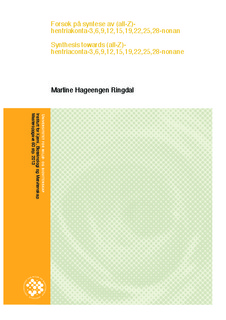| dc.description.abstract | Syntetiske studier for å lage det langkjedede, flerumettede hydrokarbonet, (3Z,6Z,9Z,12Z,15Z,19Z,22Z,25Z,28Z)-hentriakonta-3,6,9,12,15,19,22,25,28-nonan 1 har blitt utført. Dette hydrokarbonet er funnet i flere mikroorganismer, for eksempel bakterier av slekten Shewanella.
To strategier har blitt studert. Den første strategien som ble forsøkt, en koblingsreaksjon mellom alkyn 18 og bromid 19, ga ingen positive resultater. Addisjon av alkyn 18 til aldehyd 20 ble prøvd som en alternativ syntesestrategi. Dette resulterte i propargylalkohol 24 med 31 karbonatomer. Utbyttet i denne reaksjonen var 22 %.
Metoden som ble benyttet for å redusere hydroksylgruppen i forbindelse 24, via mesylatet 27 ga dessverre en blanding av to forbindelser som ikke lot seg skille ved kromatografi. Det ble i stede forsøkt å bytte ut hydroksylgruppen til et halogen. Jodidet 30 ble syntetisert og forsøkt redusert for å se om dette kunne føre fram til målmolekylet 1. Dessverre ga denne reaksjonen en blanding av flere forbindelser.
Prosedyrer for å fjerne halogener er godt kjent, og dette bør gjøres før trippelbindingen reduseres. På grunn av tiden jeg hadde til rådighet i min masteroppgave, ble ikke dette forsøkt. Med bakgrunn i det arbeidet som er gjort, skal det være gode muligheter for å syntetisere målmolekyl 1.Synthetic studies towards the long chained polyunsaturated hydrocarbon (3Z,6Z,9Z,12Z,15Z,19Z,22Z,25Z,28Z)-hentriakonta-3,6,9,12,15,19,22,25,28-nonane 1 were made. This hydrocarbon is found in several microorganisms, amongst them bacteria of the phyla Shewanella.
Two strategies were studied. A coupling reaction of alkyne 18 and bromide 19 was the first strategy. This gave no positive results. An alternative synthetic strategy was the addition of the alkyne 18 to the aldehyde 20, and this resulted in the propargylic alcohol 24 consisting of 31 carbon atoms. The yield in this reaction was 22 %.
The method used to eliminate the hydroxyl group in compound 24 via the mesylate 27 resulted in a mixture of two compounds that were inseparable by chromatography. Instead, the hydroxyl group was changed into a halogen. The iodide 30 was reduced to investigate if this could lead to the target molecule 1. Unfortunately, this reaction resulted in a mixture of different compounds.
There are known procedures to remove the halogen. This should be done before the triple bond is reduced. This was not tried out because of the limited timeframe of my master thesis. However, it should be possible to synthesise target molecule 1 using the experience acquired in this work. | no_NO |
| dc.title | Forsøk på syntese av (all-Z)-hentriakonta-3,6,9,12,15,19,22,25,28-nonan | no_NO |
| dc.title.alternative | Synthesis towards (all-Z)-hentriaconta-3,6,9,12,15,19,22,25,28-nonane | no_NO |
